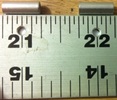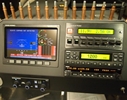


random user submitted photo
Uneven cylinder head temps...
9 posts
• Page 1 of 1
Uneven cylinder head temps...
-Hi everyone- Just a quick question. I fly a Sonex/Aerovee 2.0 and have always had about a 50-60 deg. F difference between my front cyls. (2/4) and the rear cyls (1/3) with the fronts being cooler. My friend is doing his rv-7's phase one and his cylinders on his lycoming are all within 10 degs. I am experimenting with various diversion dams within my fence baffling system to narrow this spread and have managed to get them about 15 degs. closer. What have been your experiences and how big a deal should i make this ? Just curious. George N1020X.
- jgpainter2
- Posts: 8
- Joined: Fri May 10, 2013 10:41 pm
Re: Uneven cylinder head temps...
On my Aerovee the front cylinders are about 30-40 cooler than the rear.
- radfordc
- Posts: 573
- Joined: Fri Jun 03, 2011 9:39 am
Re: Uneven cylinder head temps...
For what it's worth department...a few weeks ago I listened to EAA webinar with Mike Busch, of Savvy Aviator. He is changing the way (or trying to) mechanics should diagnose engine problems with great success by looking at trends in CHT, EGT, fuel consumption, etc., from data downloaded from engine monitoring systems. It was a very informative webinar which can be listened to any time from the EAA archives.
Here's the gotcha. I emailed him asking if any of his expertise is with VW conversions like AeroVee, Revmaster, etc. "No, only with Continental and Lycoming", was his reply.
For those engine gurus out there...do you think what he says would apply to our engines, generally speaking of course. To answer this you'd probably have to listen to his webinar presentation entitled "How to destroy your engine in 5 minutes" (or a title very similar to that). It has to do with high CHT's. He sets his warning light at 380.
Here's the gotcha. I emailed him asking if any of his expertise is with VW conversions like AeroVee, Revmaster, etc. "No, only with Continental and Lycoming", was his reply.
For those engine gurus out there...do you think what he says would apply to our engines, generally speaking of course. To answer this you'd probably have to listen to his webinar presentation entitled "How to destroy your engine in 5 minutes" (or a title very similar to that). It has to do with high CHT's. He sets his warning light at 380.
Darick Gundy
Sonex #1646
N417DG
Taildragger, Aerovee, center stick, Prince P-Tip Prop
MGL E1, F2, V6 radio, Sandia Xponder, Reserve lift indicator (AOA), iFly 520
First flight! 10/21/2017
Sonex #1646
N417DG
Taildragger, Aerovee, center stick, Prince P-Tip Prop
MGL E1, F2, V6 radio, Sandia Xponder, Reserve lift indicator (AOA), iFly 520
First flight! 10/21/2017
-

Darick - Posts: 496
- Joined: Mon Aug 05, 2013 9:39 pm
- Location: PA
Re: Uneven cylinder head temps...
On my VW forum it was stated some time ago that the Monett style intake system (like on the modern AeroVee) tends to make the front cylinders run leaner which could be the cause of the higher temps.
See post:
http://vwaircraftengines.com/viewtopic.php?f=30&t=72
See post:
http://vwaircraftengines.com/viewtopic.php?f=30&t=72
Michael
Sonex #145 from scratch (mostly)
Taildragger, 2.4L VW engine, AeroInjector, Prince 54x48 P-Tip
VH-MND, CofA issued 2nd of November 2015
First flight 7th of November 2015
Phase I Completed, 11th of February 2016
http://www.mykitlog.com/rizzz/
Sonex #145 from scratch (mostly)
Taildragger, 2.4L VW engine, AeroInjector, Prince 54x48 P-Tip
VH-MND, CofA issued 2nd of November 2015
First flight 7th of November 2015
Phase I Completed, 11th of February 2016
http://www.mykitlog.com/rizzz/
- rizzz
- Posts: 869
- Joined: Tue Jun 21, 2011 2:07 am
- Location: Wollongong, NSW, Australia
Re: Uneven cylinder head temps...
Michael sonex #145 - I think you've got it backwards. The front cylinders run cooler than the rears. This would not explain a leaner condition on the fronts - necessarily. Unless the leaner condition put the fronts in a LOP condition and left the rears in a max stress condition. I dunno. I was just looking to see if others had luck evening them out with air dams. George.
- jgpainter2
- Posts: 8
- Joined: Fri May 10, 2013 10:41 pm
Re: Uneven cylinder head temps...
George
I have the same issue and have tried at least 6 different dams on the pilot side and a couple on the passenger side. None worked. You may have better luck.
However I have noticed something interesting. My #1 like everyone else is the hottest, but depending on the wind direction the temp can vary by up to 20 degrees. That sounds crazy, but I have done a 180 turn to see the effect and it is there. So my theory on this issue is that the propeller robs the air intake on the pilot side and the wind direction either helps or hinders that robbery.
If that is correct, then the solution would be a bigger intake, or different shape on the pilot side. I haven't tried that.
I did increase the exit hole on the bottom of the cowling to give the same area as the plans but allowing for the space taken by the exhaust and the oil breather. My #1 runs around 360 and the others around 300.
I will be interested to hear if anyone else notices a wind effect.
Robin
Sonex 1071.
I have the same issue and have tried at least 6 different dams on the pilot side and a couple on the passenger side. None worked. You may have better luck.
However I have noticed something interesting. My #1 like everyone else is the hottest, but depending on the wind direction the temp can vary by up to 20 degrees. That sounds crazy, but I have done a 180 turn to see the effect and it is there. So my theory on this issue is that the propeller robs the air intake on the pilot side and the wind direction either helps or hinders that robbery.
If that is correct, then the solution would be a bigger intake, or different shape on the pilot side. I haven't tried that.
I did increase the exit hole on the bottom of the cowling to give the same area as the plans but allowing for the space taken by the exhaust and the oil breather. My #1 runs around 360 and the others around 300.
I will be interested to hear if anyone else notices a wind effect.
Robin
Sonex 1071.
- robin
- Posts: 15
- Joined: Fri Apr 04, 2014 3:45 pm
Re: Uneven cylinder head temps...
Hi Robin. Now that IS weird. I also notice a difference in CHT's downwind versus upwind, though I don't remember which way. I believe they are hotter upwind. Dosen't make sense to me either. I have gotten my temps closer by 15 degs. with my current iteration of dams - about 4" wide and 3" high or thereabouts. I will keep playing. Thanks for the input ! George. 1020X.
- jgpainter2
- Posts: 8
- Joined: Fri May 10, 2013 10:41 pm
Re: Uneven cylinder head temps...
jgpainter2 wrote:Michael sonex #145 - I think you've got it backwards. The front cylinders run cooler than the rears. This would not explain a leaner condition on the fronts - necessarily. Unless the leaner condition put the fronts in a LOP condition and left the rears in a max stress condition. I dunno. I was just looking to see if others had luck evening them out with air dams. George.
You're right,
I did get it backwards, it is indeed the fronts that run cooler so if they run leaner they should run hotter all else being equal.
Michael
Sonex #145 from scratch (mostly)
Taildragger, 2.4L VW engine, AeroInjector, Prince 54x48 P-Tip
VH-MND, CofA issued 2nd of November 2015
First flight 7th of November 2015
Phase I Completed, 11th of February 2016
http://www.mykitlog.com/rizzz/
Sonex #145 from scratch (mostly)
Taildragger, 2.4L VW engine, AeroInjector, Prince 54x48 P-Tip
VH-MND, CofA issued 2nd of November 2015
First flight 7th of November 2015
Phase I Completed, 11th of February 2016
http://www.mykitlog.com/rizzz/
- rizzz
- Posts: 869
- Joined: Tue Jun 21, 2011 2:07 am
- Location: Wollongong, NSW, Australia
Re: Uneven cylinder head temps...
Darick wrote:For those engine gurus out there...do you think what he says would apply to our engines, generally speaking of course. To answer this you'd probably have to listen to his webinar presentation entitled "How to destroy your engine in 5 minutes" (or a title very similar to that). It has to do with high CHT's. He sets his warning light at 380.
Remaining in the FWIW department ... my Aerovee exhibited the same trait of having the front cylinders cooler than the rear. Not sure whether it was from the added air to the cylinders from being up front, the overly rich mixture that was evident from the carbon build up in the cylinders, or a combination of both. I suspect the latter. After working with a few changes with the cooling baffles, turning the Aerocarb a few degrees, and tuning the carb, I could get the rear cylinders to be very close to the same temp but still hotter than the front. With the rear leaned to 1325-1350ºF in cruise the front would run just hot enough to keep the front running fairly clean and prevent plug fouling. Some blame the intake design but I'm not an engine guru and can't address why this is happening.
Mike Busch is very knowledgeable and I'm sure some of what he has learned will translate to what we do on our experimental engines. I think he is correct that 380ºF is a good limit for cylinder head temps. My Aerovee in the hot summer would run a bit higher than that but we must keep in mind as to where those numbers are coming from. A spark plug mounted CHT sender will read a few degrees different depending on whether it is above or below the plug sealing washer. The newer type senders that are being mounted on the fins read about 20ºF lower than the plug senders depending on where it is mounted on the fin. Some even use a head bolt to measure temps with a reading of 70ºF lower than the plug location. Several have done these test and others on this site can give you their results. So be sure you are comparing apples to apples. A VW engine guru that I greatly respect said that if I kept the CHTs under 400ºF as measured under the plugs, the heads would live a pretty good life. So a fin mounted CHT reading of 380ºF sounds like a good limit ... all things being equal.
Another FWIW, many of the recent Aerovee powered aircraft I've seen for sale on Barnstormers had received engine work in the previous 300 hours or less; mostly top end/head work. VW heads work very hard to shed heat when putting out high power as required for take-off and climb to cruise. Getting the baffling, ignition timing, and fuel delivery correct will give you a good little engine that performs well. But Mike is correct when he notes that long engine life comes from keeping it cool.
Dale Williams
N319WF
-

daleandee - Posts: 877
- Joined: Fri Feb 01, 2013 6:14 pm
9 posts
• Page 1 of 1
Who is online
Users browsing this forum: No registered users and 10 guests







